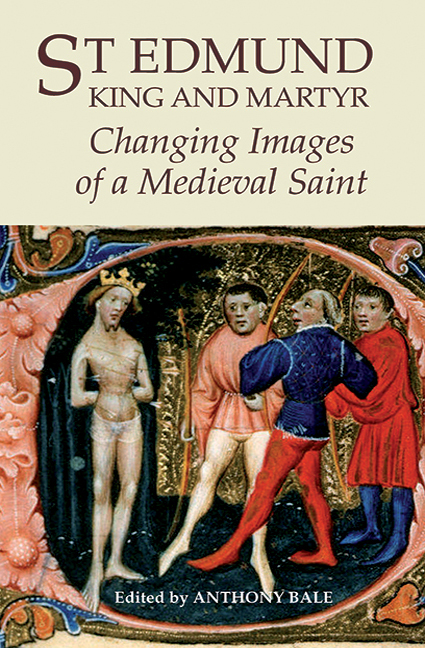Book contents
- Frontmatter
- Contents
- Preface
- List of Contributors
- List of Abbreviations
- Introduction: St Edmund's Medieval Lives
- 1 King, Martyr and Virgin: Imitatio Christi in Ælfric's Life of St Edmund
- 2 Chronology, Genealogy and Conversion: The Afterlife of St Edmund in the North
- 3 Geoffrey of Wells’ Liber de infantia sancti Edmundi and the ‘Anarchy’ of King Stephen's Reign
- 4 Music and Identity in Medieval Bury St Edmunds
- 5 Medieval images of St Edmund in Norfolk Churches
- 6 John Lydgate's Lives of Ss Edmund and Fremund: Politics, Hagiography and Literature
- 7 St Edmund in Fifteenth-Century London: The Lydgatian Miracles of St Edmund
- 8 The Later Lives of St Edmund: John Lydgate to John Stow
- Select Bibliography
- Index
- Miscellaneous Endmatter
5 - Medieval images of St Edmund in Norfolk Churches
Published online by Cambridge University Press: 11 May 2017
- Frontmatter
- Contents
- Preface
- List of Contributors
- List of Abbreviations
- Introduction: St Edmund's Medieval Lives
- 1 King, Martyr and Virgin: Imitatio Christi in Ælfric's Life of St Edmund
- 2 Chronology, Genealogy and Conversion: The Afterlife of St Edmund in the North
- 3 Geoffrey of Wells’ Liber de infantia sancti Edmundi and the ‘Anarchy’ of King Stephen's Reign
- 4 Music and Identity in Medieval Bury St Edmunds
- 5 Medieval images of St Edmund in Norfolk Churches
- 6 John Lydgate's Lives of Ss Edmund and Fremund: Politics, Hagiography and Literature
- 7 St Edmund in Fifteenth-Century London: The Lydgatian Miracles of St Edmund
- 8 The Later Lives of St Edmund: John Lydgate to John Stow
- Select Bibliography
- Index
- Miscellaneous Endmatter
Summary
visual culture was fundamental to the medieval cult of saints, with some communities ‘immortalising their particular holy man or woman in paint, stone, wood and precious metals as much as, if not more so, than in verse and prayer’. Hagiographic art could fulfil many functions and its didactic potential was recognized by contemporaries. The familiar repertoire of religious art provided a highly visible, pervasive reminder of the events described in sermons and commemorated in services, and contemporary authors frequently invoked Gregory I in support of art as a means of instructing the illiterate. In Dives and Pauper, for example, an early fifteenth-century prose commentary on the Ten Commandments, Dives, a layman, asks his adviser, Pauper, to teach him about images, the ‘book of lewyd peple’.
The visual arts were the driving force behind the pilgrim trade. Images could be used as a means of advertising the efficacy of the saint, with the area around a shrine frequently adorned with representations of the miracles ascribed to that individual, and pilgrim badges were a means by which knowledge of a cult could be transmitted. In the absence of relics an image could become the focus of a miracle-working cult, with some of the most popular and reputedly efficacious shrines based primarily around images, such as Walsingham or Bromholm in Norfolk. It was this perceived ability of images to act as conduits for the power of the individual they depicted that led some to be critical of what they saw as superstition and idolatry.
Richard Gameson suggests that ‘by the means of depictions, one could appropriate and possess any saint or particular figure’. ‘Appropriation’ implies a degree of ownership, which the elevated status of saints within medieval religion renders unlikely; saints were, after all, the conduits through which flowed the power of God. Rather than a one-way transaction, with the saint obediently at the behest of the community, the decision to depict a particular saint represented the creation of a mutually beneficent relationship; an individual or parochial community would have hoped to attract the intercessory favour of the one depicted in return for identifying that particular saint as especially worthy of devotion.
- Type
- Chapter
- Information
- St Edmund, King and MartyrChanging Images of a Medieval Saint, pp. 111 - 132Publisher: Boydell & BrewerPrint publication year: 2009

